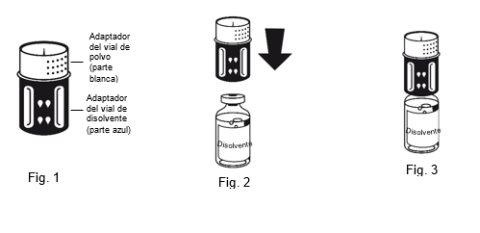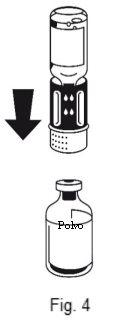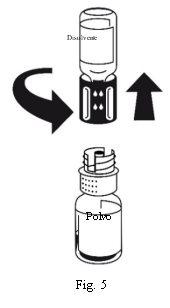
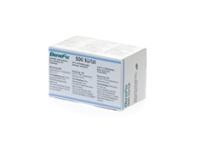
ОКТАНИН 100 МЕ/мл ПОРОШОК И РАСТВОРИТЕЛЬ ДЛЯ ПРИГОТОВЛЕНИЯ ИНЪЕКЦИОННОГО РАСТВОРА

Спросите врача о рецепте на ОКТАНИН 100 МЕ/мл ПОРОШОК И РАСТВОРИТЕЛЬ ДЛЯ ПРИГОТОВЛЕНИЯ ИНЪЕКЦИОННОГО РАСТВОРА

Инструкция по применению ОКТАНИН 100 МЕ/мл ПОРОШОК И РАСТВОРИТЕЛЬ ДЛЯ ПРИГОТОВЛЕНИЯ ИНЪЕКЦИОННОГО РАСТВОРА
Введение
Инструкция: информация для пользователя
Октанин 100 МЕ/мл, порошок и растворитель для инъекционного раствора
Фактор IX свертывания человеческой крови
Прочитайте внимательно всю инструкцию перед началом использования этого лекарства, поскольку она содержит важную информацию для вас.
- Сохраните эту инструкцию, поскольку вам может потребоваться прочитать ее снова.
- Если у вас есть какие-либо вопросы, проконсультируйтесь с вашим врачом, фармацевтом или медсестрой.
- Это лекарство было назначено только вам и не должно быть передано другим людям, даже если они имеют те же симптомы, что и вы, поскольку оно может нанести им вред.
- Если вы испытываете побочные эффекты, проконсультируйтесь с вашим врачом, фармацевтом или медсестрой, даже если это побочные эффекты, которые не указаны в этой инструкции. См. раздел 4.
Содержание инструкции:
- Что такое Октанин и для чего он используется
- Что вам нужно знать перед началом использования Октанина
- Как использовать Октанин
- Возможные побочные эффекты
- Хранение Октанина
- Содержание упаковки и дополнительная информация
1. Что такое Октанин и для чего он используется
Октанин относится к группе лекарств, называемых факторами свертывания, и содержит фактор IX свертывания человеческой крови. Это специальный белок, который увеличивает способность крови свертываться.
Октанин используется для лечения и профилактики кровотечений у пациентов с кровяными расстройствами (гемофилией Б). Это заболевание, при котором кровотечение может длиться дольше, чем ожидается. Оно вызвано врожденным дефектом количества фактора IX свертывания в крови.
Октанин выпускается в виде порошка и растворителя для приготовления инъекционного раствора. После восстановления он вводится внутривенно (введен в вену).
2. Что вам нужно знать перед началом использования Октанина
Не используйте Октанин:
- если вы аллергичны к фактору IX свертывания человеческой крови или к любому другому компоненту этого лекарства (перечисленному в разделе 6).
- если у вас есть тромбоцитопения II типа, индуцированная гепарином, которая является снижением количества тромбоцитов в крови после введения гепарина. Тромбоциты - это кровяные клетки, которые помогают остановить кровотечение. Гепарин - это лекарство, используемое для предотвращения血яных сгустков.
Предостережения и меры предосторожности
- Проконсультируйтесь с вашим врачом, фармацевтом или медсестрой перед началом использования Октанина.
- Как и все лекарства, содержащие белки и вводимые внутривенно, могут возникать реакции гиперчувствительности аллергического типа. Октанин содержит очень небольшие количества различных человеческих белков, кроме фактора IX и гепарина. Первые признаки реакций гиперчувствительности включают:
- сыпь
- кожная сыпь (уртикария)
- давление в груди
- затруднение дыхания
- снижение артериального давления
- острая и тяжелая аллергическая реакция (анафилаксия, когда один или все вышеперечисленные симптомы развиваются быстро и интенсивно)
Если появляются эти симптомы, немедленно прекратите введение и проконсультируйтесь с вашим врачом. В случае анафилактического шока необходимо начать рекомендуемое лечение как можно скорее.
- Ваш врач может порекомендовать вам рассмотреть возможность вакцинации против гепатита А и В, если вы регулярно или повторно получаете продукты, полученные из человеческой плазмы, содержащие фактор IX.
- Известно, что лица с гемофилией Б могут развивать ингибиторы (нейтрализующие антитела) фактора IX, произведенные иммунными клетками. Ингибиторы могут увеличить риск развития анафилактического шока (тяжелых аллергических реакций). Поэтому, если у вас возникает аллергическая реакция, необходимо проанализировать наличие ингибитора. Пациенты с ингибиторами фактора IX могут иметь более высокий риск анафилаксии, если они лечатся фактором IX. Поэтому ваш врач может решить ввести первую дозу фактора IX под медицинским наблюдением, чтобы оказать вам соответствующую помощь в случае аллергических реакций.
- Концентраты белков фактора IX могут вызвать закупорку кровеносных сосудов сгустком. Из-за этого риска, который выше в продуктах низкой чистоты, необходимо контролировать симптомы образования сгустков в крови после введения продуктов фактора IX, если у вас:
- присутствуют признаки фибринолиза (кровяных сгустков, которые распались)
- присутствует диссеминированная внутренняя коагуляция (распространенная коагуляция крови внутри кровеносных сосудов)
- у вас диагностирована печеночная болезнь
- у вас есть документированные факторы риска сердечно-сосудистых заболеваний
- у вас была недавно проведена операция
- у вас высокий риск образования сгустков или диссеминированной внутренней коагуляции.
Если любой из вышеперечисленных симптомов актуален для вас, ваш врач введет Октанин только в том случае, если польза превышает риски.
- После повторного лечения продуктами, содержащими фактор IX свертывания человеческой крови, необходимо наблюдать у пациентов возможное развитие нейтрализующих антител (ингибиторов), которые должны количественно определяться в единицах Бетесда (ЕБ) с использованием соответствующих биологических тестов.
Вирусная безопасность крови
- При введении лекарств, полученных из человеческой плазмы или крови, необходимо принять определенные меры, чтобы предотвратить передачу инфекций пациентам. Такие меры включают тщательный отбор доноров, чтобы исключить тех, кто находится в группе риска быть носителями инфекционных заболеваний, анализ специфических маркеров инфекций в индивидуальных донорских материалах и в плазменных смесях, а также включение этапов в процессе производства для удаления/инактивации вирусов. Несмотря на это, при введении лекарств, полученных из человеческой крови или плазмы, возможность передачи инфекционных агентов не может быть полностью исключена. Это также относится к возникающим вирусам или вирусам неизвестной природы или другим типам инфекций.
- Эти меры считаются эффективными для вирусов с оболочкой, таких как вирус иммунодефицита человека (ВИЧ), вирус гепатита Б и вирус гепатита С, а также для необолоченного вируса гепатита А. Меры, принимаемые для других необолоченных вирусов, таких как парвовирус Б19, могут иметь ограниченную ценность. Инфекция парвовирусом Б19 может быть тяжелой для беременной женщины (инфекция плода) и для людей с ослабленной иммунной системой или у пациентов с некоторыми типами анемии (например, серповидно-клеточной анемии или гемолитической анемии).
- Возможно, ваш врач порекомендует вам вакцинацию против гепатита А и гепатита В, если вам регулярно или повторно вводятся лекарства, полученные из человеческой плазмы.
- Рекомендуется вести учет введения каждой дозы Октанина с указанием названия лекарства и номера партии, чтобы поддерживать регистр использованных партий.
Дети
Если Октанин вводится новорожденному, необходимо тщательно наблюдать за признаками диссеминированной внутренней коагуляции у ребенка.
Другие лекарства и Октанин
- Насколько нам известно, продукты, содержащие фактор IX свертывания человеческой крови, не взаимодействуют с какими-либо другими лекарствами.
Сообщите вашему врачу или фармацевту, если вы используете или最近 использовали другие лекарства, включая те, которые можно приобрести без рецепта.
Беременность и лактация
Нет данных о использовании фактора IX во время беременности и лактации. Поэтому фактор IX должен использоваться во время беременности и лактации только в том случае, если это явно показано.
Если вы беременны или кормите грудью, считаете, что могли бы быть беременной или планируете стать беременной, проконсультируйтесь с вашим врачом или фармацевтом перед использованием этого лекарства.
Вождение и использование машин
Не было обнаружено влияния на способность управлять транспортными средствами и использовать машины.
Октанин содержит натрий
Это лекарство содержит до 69 мг натрия (основного компонента поваренной соли) в 1 флаконе Октанина 500 МЕ, что эквивалентно 3,45% от максимально допустимой суточной нормы потребления натрия для взрослого человека, и до 138 мг натрия в 1 флаконе Октанина 1000 МЕ, что эквивалентно 6,9% от максимально допустимой суточной нормы потребления натрия для взрослого человека.
Это должно быть учтено при лечении пациентов с диетами, бедными натрием.
3. Как использовать Октанин
Следуйте точно инструкциям по введению этого лекарства, указанным вашим врачом. В случае сомнений проконсультируйтесь с вашим врачом или фармацевтом.
Октанин должен вводиться внутривенно (введен в вену) после восстановления с растворителем, прилагаемым к лекарству.
Используйте только оборудование для инфузии, поставляемое с лекарством. Использование другого оборудования для инъекции/инфузии может вызвать дополнительные риски и привести к неудаче лечения.
Лечение должно быть начато под наблюдением врача с опытом лечения гемофилии. Количество Октанина, которое необходимо использовать, и продолжительность заместительной терапии зависят от тяжести вашего дефекта фактора IX. Это также зависит от места и степени кровотечения, а также от вашего клинического состояния.
Расчет дозы:
Ваш врач укажет, с какой частотой и в какой дозе вам необходимо вводить Октанин.
Доза фактора IX выражается в международных единицах (МЕ). Активность фактора IX в плазме относится к количеству фактора IX, присутствующего в плазме. Она выражается либо в процентах (относительно нормальной человеческой плазмы), либо в международных единицах (относительно международного стандарта для фактора IX в плазме).
Одна международная единица (МЕ) активности фактора IX эквивалентна количеству фактора IX в 1 миллилитре нормальной человеческой плазмы. Расчет необходимой дозы фактора IX основан на наблюдении, что 1 МЕ фактора IX на килограмм веса тела увеличивает активность фактора IX в плазме на 1% от нормальной активности. Для расчета необходимой вам дозы измеряется уровень активности фактора IX в вашей крови. Это покажет, насколько необходимо увеличить активность.
Необходимая доза рассчитывается по следующей формуле:
Требуемые единицы = вес тела (кг) x желаемое увеличение фактора IX (%) (МЕ/дл) x 0,8
Размер вашей дозы и частота введения будут зависеть от того, как вы реагируете на лекарство, и будут определяться вашим врачом. Продукты фактора IX редко требуют введения более одного раза в день.
Ваша реакция на продукты фактора IX может быть переменной. Поэтому необходимо измерять ваши уровни фактора IX во время лечения, чтобы рассчитать правильную дозу и частоту инфузии. Особенно во время хирургических операций ваш врач будет использовать анализы крови (активность плазменного фактора IX), чтобы внимательно контролировать заместительную терапию.
Профилактика кровотечения:
Если у вас тяжелая гемофилия Б, вам необходимо вводить 20-40 МЕ фактора IX на килограмм веса тела (ВТ). Эту дозу необходимо вводить дважды в неделю для долгосрочной профилактики. Ваша доза должна быть скорректирована в зависимости от вашей реакции. В некоторых случаях, особенно у молодых пациентов, могут потребоваться более короткие интервалы введения или более высокие дозы.
Использование у детей:
В исследовании, проведенном у детей младше 6 лет, средняя введенная доза в день экспозиции составила 40 МЕ/кг ВТ.
Если кровотечение не останавливается из-за ингибиторов:
Если не достигается ожидаемая активность фактора IX после введения или кровотечение не останавливается после введения правильной дозы, необходимо сообщить об этом вашему врачу. Он проанализировает вашу кровь, чтобы увидеть, развили ли вы ингибиторы (антитела) против белка фактора IX. Эти ингибиторы могут уменьшить активность фактора IX. В этом случае может потребоваться другой метод лечения. Ваш врач обсудит это с вами и порекомендует другое лечение, если это необходимо.
Если вы используете больше Октанина, чем необходимо
Не были обнаружены симптомы передозировки фактором IX свертывания человеческой крови. Однако не следует превышать рекомендуемую дозу.
Для "Инструкций по лечению дома" см. упаковку оборудования.
4. Возможные побочные эффекты
Как и все лекарства, Октанин может вызывать побочные эффекты, хотя не все люди испытывают их.
- Редко наблюдались реакции гиперчувствительности или аллергические реакции у пациентов, леченных продуктами, содержащими фактор IX. Эти реакции могут включать:
- спазмы кровеносных сосудов с отеком лица, рта и горла
- жжение и покалывание в месте инфузии
- озноб
- покраснение
- кожная сыпь
- головная боль
- уртикария
- снижение артериального давления
- усталость
- дискомфорт
- беспокойство
- учащенное сердцебиение
- давление в груди
- покалывание
- рвота
- затруднение дыхания
В некоторых случаях эти аллергические реакции могут привести к тяжелой реакции, называемой анафилаксией, которая может включать шок. Обычно эти реакции связаны с развитием ингибиторов фактора IX. Если вы испытываете один из вышеперечисленных симптомов, сообщите об этом вашему врачу.
- Если у вас гемофилия Б, вы можете развить нейтрализующие антитела (ингибиторы) фактора IX. Эти антитела могут нарушить эффективность вашего лекарства. Ваш врач обсудит это с вами и порекомендует другое лечение, если это необходимо.
Было проведено исследование у 25 детей с гемофилией Б, из которых 6 пациентов не были лечены ранее. Не было обнаружено никаких ингибиторов во время исследования. Переносимость всех инъекций была оценена как "очень хорошая" или "хорошая".
- Некоторые пациенты с гемофилией Б и ингибиторами фактора IX с иммунотолерантной терапией и историей аллергических реакций развили нефротический синдром (тяжелое заболевание почек).
- В редких случаях может возникнуть лихорадка.
- Продукты фактора IX низкой чистоты редко могут вызвать образование кровяного сгустка внутри кровеносных сосудов. Это может привести к некоторым из следующих осложнений:
- инфаркт миокарда
- распространенная коагуляция крови внутри кровеносных сосудов (диссеминированная внутренняя коагуляция)
- кровяные сгустки в венах (венозный тромбоз)
- кровяные сгустки в легких (пульмональная эмболия).
Эти побочные эффекты более часто встречаются, если используются продукты фактора IX низкой чистоты, и редки, если используются продукты высокой чистоты, такие как Октанин.
- Гепарин в препарате может вызвать внезапное снижение количества тромбоцитов в крови ниже 100 000 на микролитр или менее 50% от исходного количества. Это аллергическая реакция, называемая "тромбоцитопения II типа, индуцированная гепарином". В редких случаях у пациентов, которые не являются ранее гиперчувствительными к гепарину, это снижение количества тромбоцитов может возникнуть через 6-14 дней после начала лечения. У пациентов с ранее существовавшей гиперчувствительностью к гепарину это нарушение может развиться в течение нескольких часов после начала лечения. Это тяжелое снижение количества тромбоцитов может сопровождаться или привести к:
- кровяным сгусткам в артериях и венах
- закупорке кровеносного сосуда сгустком из другой области
- тяжелому нарушению коагуляции, называемому коагулопатией потребления
- гангрене кожи в области инъекции
- кровотечению с видом укуса насекомого
- гематомам
- фекалиям цвета дегтя.
Если вы наблюдаете эти аллергические реакции, немедленно прекратите инъекции Октанином и не используйте в будущем лекарства, содержащие гепарин.Из-за этого редкого эффекта на тромбоциты ваш врач будет внимательно контролировать количество тромбоцитов в вашей крови, особенно при начале лечения.
Для безопасности в отношении передаваемых агентов см. раздел 2.
Сообщение о побочных эффектах
Если вы испытываете любой побочный эффект, сообщите об этом вашему врачу, фармацевту или медсестре, даже если это побочные эффекты, которые не указаны в этой инструкции. Вы также можете сообщить об этом напрямую через систему фармаковигиланса: www.notificaRAM.es.
Сообщая о побочных эффектах, вы можете внести свой вклад в предоставление более полной информации о безопасности этого лекарства.
5. Хранение Октанина
Храните это лекарство в недоступном для детей месте.
Храните флакон в наружной упаковке, чтобы защитить его от света, и при температуре ниже +25°C. Не замораживайте.
Не используйте это лекарство после истечения срока годности, указанного на этикетке и упаковке. Срок годности - последний день месяца, указанного на упаковке.
Рекомендуется использовать восстановленный продукт сразу, и в противном случае - не позднее 8 часов после хранения при комнатной температуре (25°C). Используйте Октанин однократно.
Не используйте это лекарство, если вы наблюдаете мутные растворы или если они не полностью растворены. Утилизируйте неиспользованный содержимое. Лекарства не должны выбрасываться в канализацию или мусор. Спросите вашего фармацевта, как утилизировать упаковку и лекарства, которые вам больше не нужны. Таким образом, вы поможете защитить окружающую среду.
6. Содержимое упаковки и дополнительная информация
Состав Октанина
Активное вещество- фактор IX свертывания крови человека.
Другие компоненты- гепарин, хлорид натрия, цитрат натрия, гидрохлорид аргинина и гидрохлорид лизина.
Внешний вид Октанина и содержимое упаковки
Октанин выпускается в 2 размерах упаковки с следующими дозировками:
- Октанин 100 МЕ/мл, предназначенный для реconstitution с 5 мл воды для инъекций, выпускается в виде порошка и растворителя для инъекции с номинальным содержанием 500 МЕ фактора IX свертывания крови человека на флакон.
- Октанин 100 МЕ/мл, предназначенный для реconstitution с 10 мл воды для инъекций, выпускается в виде порошка и растворителя для инъекции с номинальным содержанием 1000 МЕ фактора IX свертывания крови человека на флакон.
Октанин производится из плазмы доноров крови.
Потенция (МЕ) определяется с помощью одностадийного теста свертывания по европейской фармакопее, сравнивая его со стандартом Всемирной организации здравоохранения (ВОЗ). Специфическая активность Октанина составляет примерно 100 МЕ/мг белка.
Описание упаковки:
Октанин поставляется в виде комбинированного пакета, содержащего два соединенных пластиковым замком блока:
Один блок содержит 1 флакон с порошком для инъекционного раствора и инструкцию.
Другой блок содержит флакон с растворителем (вода для инъекций, 5 мл для дозировки 500 МЕ и 10 мл для дозировки 1000 МЕ).
Эта упаковка также содержит следующие медицинские устройства:
- 1 блок оборудования для внутривенных инъекций (1 набор для передачи, 1 набор для перфузии, 1 одноразовая шприц)
- 2 спиртовых тампона
Владелец разрешения на маркетинг и ответственный за производство
Для получения любой информации о этом лекарстве обратитесь к владельцу разрешения на маркетинг.
Octapharma S.A.
Parq. Em. S. Fernando,
Avda. Castilla 2 - Edif. Dublin - 2ª Planta,
San Fernando de Henares (Madrid) 28830
Ответственный за производство:
Octapharma Pharmazeutika Produktionsges.m.b.H.
Oberlaaer Strasse 235
A-1100 Вена
Австрия
или
Octapharma S.A.S.
70-72 Rue du Maréchal Foch
67380 Lingolsheim
Франция
Дата последнего обзора этой инструкцииНоябрь 2020 г.
Подробная и актуальная информация о этом лекарстве доступна на сайте Агентства по лекарственным средствам и медицинским изделиям Испании (AEMPS)
http://www.aemps.gob.es/
Инструкции для амбулаторного лечения
- Пожалуйста, прочитайте все инструкции и следуйте имаккуратно.
- Не используйтеОктанин после даты истечения срока годности, указанной на этикетке и упаковке.
- Во время описанной ниже процедуры необходимо поддерживать стерильность.
- Визуально осмотрите реконструированное лекарство, чтобы проверить наличие частиц или изменения цвета перед введением
- Раствор должен быть прозрачным или слегка опалесцирующим. Не используйте мутные растворы или содержащие осадки.
- Используйте приготовленный раствор сразу, чтобы избежать микробного загрязнения.
- Используйте только включенный в комплект набор для перфузии. Использование другого оборудования для инъекции/перфузии может привести к дополнительному риску и неудаче лечения.
Инструкции для приготовления раствора:
|
|
|
|
|
Растворение завершается менее чем за 10 минут при комнатной температуре. Во время приготовления может появиться легкая пена. Отверните две части набора для передачи (рис. 5). Пена исчезнет. Утилизируйте пустой флакон с растворителем вместе с синей частью набора для передачи. |
|
Инструкции для инъекции:
В качестве меры предосторожности необходимо измерить частоту сердечных сокращений перед и во время инъекции. Если частота сердечных сокращений увеличивается сильно, уменьшите скорость инъекции или приостановите введение на короткий период.
- Подключите шприц к белой части набора для передачи. Переверните флакон и извлеките раствор внутрь шприца (рис. 6). Раствор должен быть прозрачным или слегка опалесцирующим.
Как только раствор будет перенесен, крепко удерживайте поршень шприца (держите его внизу) и извлеките шприц из набора для передачи (рис. 7). Утилизируйте пустой флакон вместе с белой частью набора для передачи.
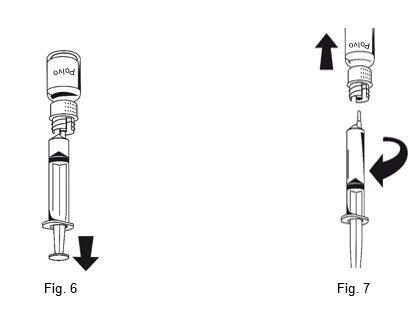
- Очистите место, где будет введена инъекция, одним из включенных спиртовых тампонов.
- Подключите включенный в комплект набор для перфузии к шприцу.
- Вставьте иглу для инъекции в выбранную вену. Если вы использовали жгут, чтобы лучше увидеть вену, этот жгут должен быть снят перед началом введения Октанина.
Не должно быть кровотечения внутрь шприца из-за риска образования фибриновых сгустков.
- Введение раствора внутривенно с медленной скоростью, не превышающей 2-3 мл в минуту.
Если вы используете более одного флакона с порошком Октанина для лечения, вы можете использовать одну и ту же иглу для инъекции и шприц.
Набор для передачи является одноразовым.
Утилизация неиспользованного лекарства и всех материалов, которые были в контакте с ним, будет осуществляться в соответствии с местными правилами.
- Страна регистрации
- Активное вещество
- Требуется рецептДа
- Производитель
- Информация носит справочный характер и не является медицинской рекомендацией. Перед приемом любых препаратов проконсультируйтесь с врачом. Oladoctor не несет ответственности за медицинские решения, принятые на основе этого контента.
- Аналоги ОКТАНИН 100 МЕ/мл ПОРОШОК И РАСТВОРИТЕЛЬ ДЛЯ ПРИГОТОВЛЕНИЯ ИНЪЕКЦИОННОГО РАСТВОРАФорма выпуска: ИНЪЕКЦИОННЫЙ РАСТВОР, 1000 МЕАктивное вещество: фактор свертывания крови человека IXПроизводитель: Swedish Orphan Biovitrum Ab (Publ)Требуется рецептФорма выпуска: ИНЪЕКЦИОННЫЙ РАСТВОР, 2000 МЕАктивное вещество: фактор свертывания крови человека IXПроизводитель: Swedish Orphan Biovitrum Ab (Publ)Требуется рецептФорма выпуска: ИНЪЕКЦИОННЫЙ РАСТВОР, 250 МЕАктивное вещество: фактор свертывания крови человека IXПроизводитель: Swedish Orphan Biovitrum Ab (Publ)Требуется рецепт
Аналоги ОКТАНИН 100 МЕ/мл ПОРОШОК И РАСТВОРИТЕЛЬ ДЛЯ ПРИГОТОВЛЕНИЯ ИНЪЕКЦИОННОГО РАСТВОРА в других странах
Лучшие аналоги с тем же действующим веществом и терапевтическим эффектом.
Аналог ОКТАНИН 100 МЕ/мл ПОРОШОК И РАСТВОРИТЕЛЬ ДЛЯ ПРИГОТОВЛЕНИЯ ИНЪЕКЦИОННОГО РАСТВОРА в Poland
Аналог ОКТАНИН 100 МЕ/мл ПОРОШОК И РАСТВОРИТЕЛЬ ДЛЯ ПРИГОТОВЛЕНИЯ ИНЪЕКЦИОННОГО РАСТВОРА в Ukraine
Врачи онлайн по ОКТАНИН 100 МЕ/мл ПОРОШОК И РАСТВОРИТЕЛЬ ДЛЯ ПРИГОТОВЛЕНИЯ ИНЪЕКЦИОННОГО РАСТВОРА
Консультация по дозировке, побочным эффектам, взаимодействиям, противопоказаниям и продлению рецепта на ОКТАНИН 100 МЕ/мл ПОРОШОК И РАСТВОРИТЕЛЬ ДЛЯ ПРИГОТОВЛЕНИЯ ИНЪЕКЦИОННОГО РАСТВОРА – по решению врача и с учетом местных правил.




